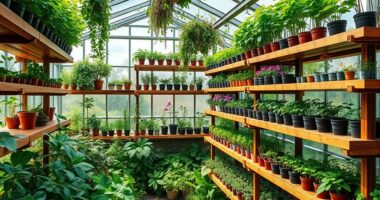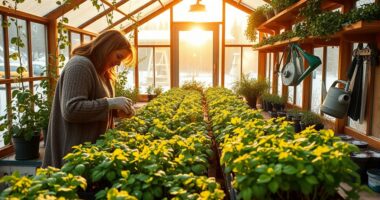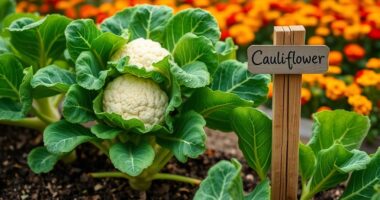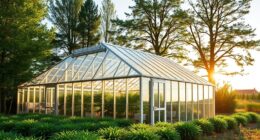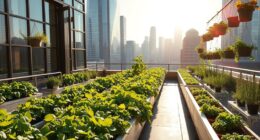If you're looking to elevate your gardening game, I recommend exploring modern greenhouse designs that suit your style and climate. A Year-Round Solar Greenhouse can provide a sustainable growing environment, while DIY options, like those in the Black & Decker guide, allow for personalization. Consider kits like the Yardenaler or CDCASA for ease of assembly. Each design guarantees ideal conditions for your plants and enhances your outdoor space. Stick around to discover more insights on these fantastic options!
Key Takeaways
- Modern greenhouses utilize advanced materials like polycarbonate for better insulation and durability, enhancing plant growth and reducing maintenance.
- Incorporating adjustable roof designs maximizes light exposure and UV protection, tailored to specific plant needs and climate conditions.
- Modular designs promote space efficiency, allowing for vertical gardening and easy scalability as gardening needs evolve.
- Enhanced climate control systems, including ventilation and humidity management, ensure optimal growing conditions year-round.
- Aesthetically pleasing designs with decorative features can elevate outdoor spaces while promoting sustainable gardening practices through efficient drainage systems.
The Year-Round Solar Greenhouse: Design and Build a Net-Zero Energy Greenhouse
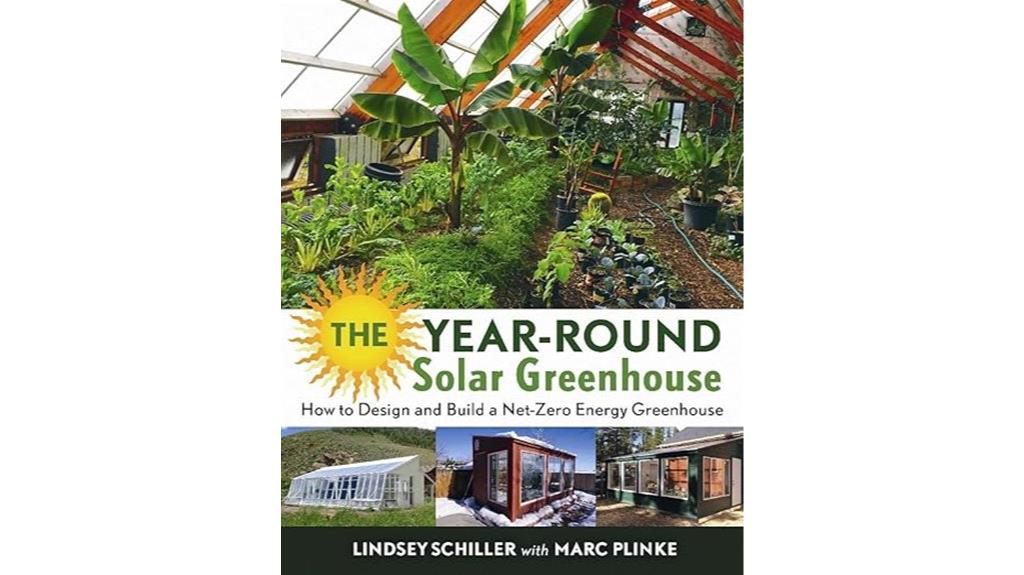
If you're looking to create an efficient and sustainable growing environment, "The Year-Round Solar Greenhouse" is the perfect choice for you. I found this book engaging and packed with practical advice, making it easy to understand various greenhouse building methods. While it offers innovative concepts like the underground piping system, it's best suited for those who are handy. I appreciated the clear explanations and diagrams, which helped me visualize my project. Although I wished for more detailed instructions on certain techniques, the book sparked my interest in exploring further resources to enhance my greenhouse construction skills.
Best For: Those who are handy and interested in building a sustainable greenhouse that operates year-round.
Pros:
- Comprehensive coverage of various greenhouse building methods and innovative design concepts.
- Engaging writing style with clear explanations and helpful diagrams.
- Provides practical advice and recommendations for further reading, enhancing knowledge on greenhouse construction.
Cons:
- May lack full details for specific implementations, requiring additional resources for deeper guidance.
- Some readers desire more detailed information on certain techniques.
- Best suited for individuals with prior experience or skills in construction and gardening.
How to Build Your Own Greenhouse: Designs and Plans
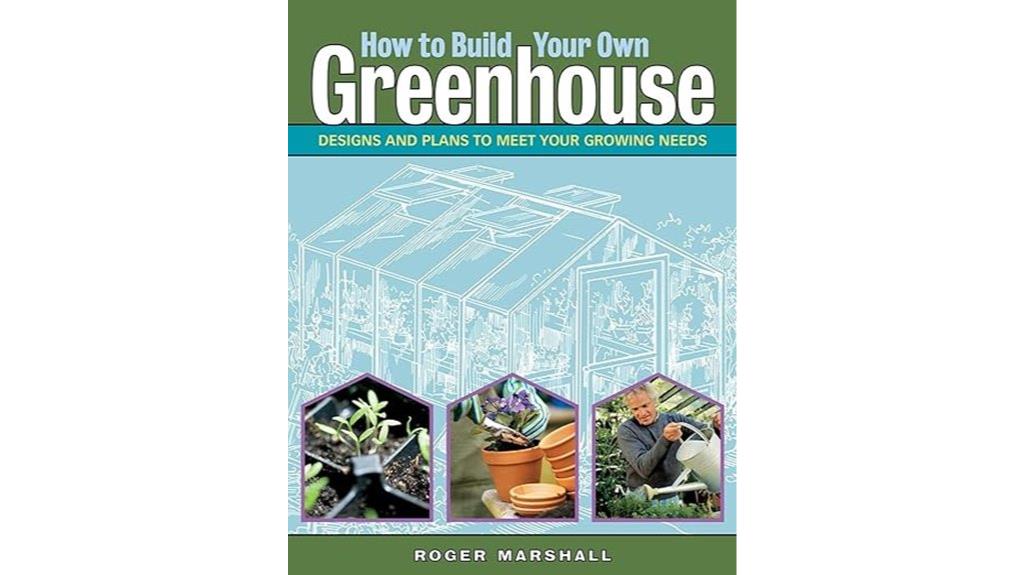
Building your own greenhouse can be an exciting project, especially for those who want to tailor their space to specific plants and climates. I recommend checking out a thorough resource that covers everything from basic designs to advanced concepts. This book is perfect for all skill levels, addressing common challenges like humidity and material selection. It even touches on aquaponics if you're interested in that integration. Whether you're building a simple cold frame or a sophisticated structure, the detailed guidance will help you create a greenhouse that meets your unique gardening goals. Explore multiple resources for the best fit!
Best For: DIY builders and gardening enthusiasts looking for comprehensive guidance on greenhouse construction tailored to various climates and plant types.
Pros:
- Comprehensive resource covering both basic and advanced greenhouse designs.
- Accessible to readers of all skill levels, making it suitable for novices and experienced builders alike.
- Offers valuable insights on integrating aquaponics and retrofitting existing structures.
Cons:
- Some may find the level of detail overwhelming for simpler projects.
- Limited coverage of aquaponics, which might not satisfy all readers interested in that aspect.
- Readers seeking a quick reference may need to sift through extensive information for their specific needs.
Black & Decker Complete Guide to DIY Greenhouses
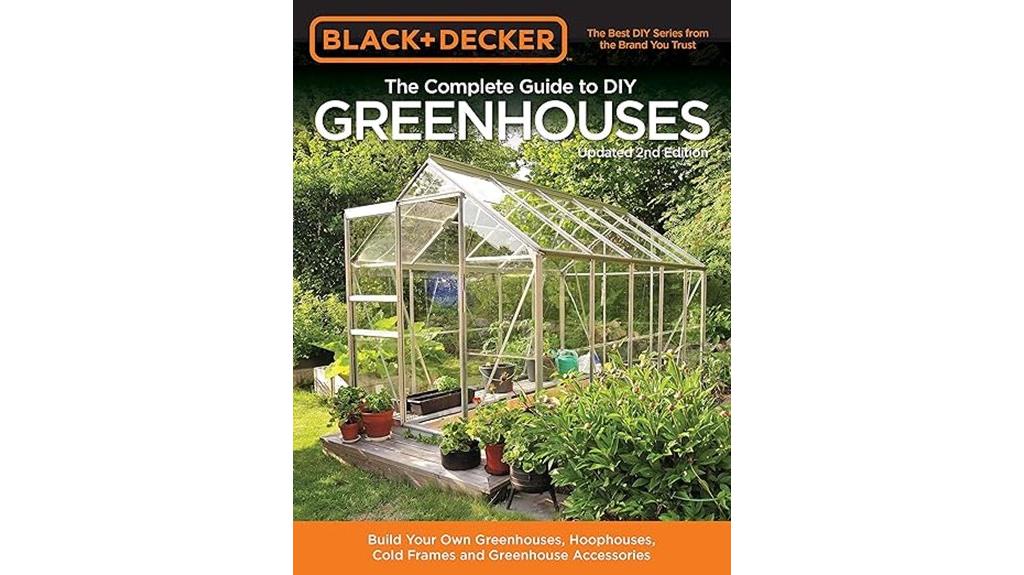
For anyone enthusiastic to plunge into the world of greenhouse gardening, the "Black & Decker Complete Guide to DIY Greenhouses" stands out as an invaluable resource. It covers everything from building techniques to essential features like flooring and ventilation. I've found the detailed construction plans and beautiful color photos incredibly helpful. Readers rave about the variety of designs, catering to different needs, whether small or large. While I did encounter a minor issue with shelf dimensions, the thorough advice has been instrumental in moving forward with my projects. Overall, it's a must-have for anyone serious about greenhouse gardening.
Best For: Anyone looking to build their own greenhouse and seeking comprehensive guidance on design and construction techniques.
Pros:
- Detailed construction plans provide clear guidance for various greenhouse designs.
- Beautiful color photography enhances understanding and inspiration for projects.
- Variety of options caters to different sizes and gardening needs, making it suitable for beginners and experienced gardeners alike.
Cons:
- Some users may encounter inaccurate dimensions for specific projects, requiring careful double-checking.
- Limited focus on advanced greenhouse technologies or automation for high-tech gardening enthusiasts.
- May not cover every possible design or setup, potentially leaving out niche interests.
GREENHOUSE GARDENING FOR BEGINNERS: Complete Guide to Growing Vegetables and Fruits

Choosing the right greenhouse design is essential for beginners enthusiastic to explore greenhouse gardening. I've found that greenhouses extend my growing season, letting me cultivate fruits and vegetables year-round, even in less-than-ideal climates. This guide covers everything from selecting and building a greenhouse to maintaining it effectively. It's packed with crop guides for popular plants, making it a handy resource for novices. While some details might feel basic, it's perfect for absolute beginners. Just keep in mind that it could lean more toward commercial setups than home gardening, so tailor your approach to suit your needs. Happy gardening!
Best For: Absolute beginners looking to learn the fundamentals of greenhouse gardening and extend their growing season for fruits and vegetables.
Pros:
- Comprehensive guide covering essential topics like selecting, building, and maintaining a greenhouse.
- Includes detailed crop guides for popular greenhouse plants, making it a useful resource for novices.
- Helps save money on produce by teaching efficient growing techniques and avoiding common mistakes.
Cons:
- Content may be too basic for readers with some prior knowledge of gardening, offering little actionable advice.
- Quality issues noted, including lack of proofreading and unclear statements that could confuse readers.
- Focus on commercial setups may not align with the needs of casual home gardeners seeking practical solutions.
DREAM GREENHOUSE FOR BEGINNERS: THE ULTIMATE BEGINNER COURSE
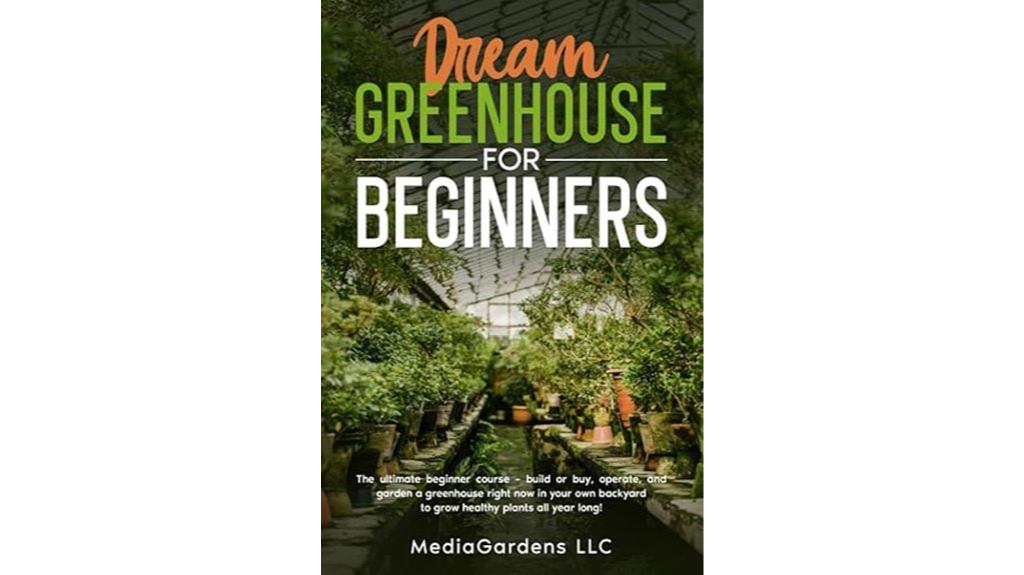
If you're enthusiastic to plunge into greenhouse gardening but feel overwhelmed by the options, "Dream Greenhouse for Beginners" is tailored just for you. This extensive guide walks you through every step of constructing and maintaining your greenhouse, from site selection to choosing the right materials. It covers essential climate control systems and offers practical tips on plant care and nutrient management. You'll learn about ideal plant selection and how to balance soil pH for healthy growth. Readers rave about its clarity and engaging content, making it an invaluable resource for anyone keen to cultivate a thriving greenhouse garden.
Best For: Beginners interested in greenhouse gardening who seek a comprehensive guide to constructing and maintaining their own greenhouse.
Pros:
- Well-organized and informative, making complex topics easy to understand for novices.
- Step-by-step instructions on construction and maintenance, ensuring a manageable approach to greenhouse gardening.
- Engaging content that keeps readers motivated and excited about starting their gardening journey.
Cons:
- May not cover advanced techniques or specialized topics for experienced gardeners.
- Some readers might find the initial setup costs higher than expected.
- Limited focus on specific plant types or advanced nutrient management practices.
6 x 10 FT Polycarbonate Greenhouse with Aluminum Frame

The 6 x 10 FT Polycarbonate Greenhouse with Aluminum Frame is perfect for backyard gardeners seeking to extend their growing season. I love how easy it is to set up—just slide in the polycarbonate panels, and you're good to go! With its sturdy aluminum frame, this greenhouse can withstand harsh weather, ensuring my plants stay safe. The adjustable roof vent promotes airflow, and the innovative drainage system keeps things tidy. Plus, if I ever need help, their customer support is available 24/7. Overall, it's a fantastic investment for anyone serious about gardening!
Best For: Backyard gardeners seeking to extend their growing season with a durable and easy-to-install greenhouse.
Pros:
- Quick and easy setup with slide-in polycarbonate panels, making installation a breeze.
- Sturdy aluminum frame provides durability and stability, allowing it to withstand harsh weather conditions.
- Adjustable ventilation system enhances airflow and supports optimal plant health.
Cons:
- Size limitations may not be suitable for larger gardening projects or extensive plant collections.
- Polycarbonate panels may require occasional cleaning to maintain clarity and sunlight penetration.
- Initial cost may be higher compared to smaller or simpler greenhouse options.
6×12 FT Greenhouse Kit for Outdoor

For gardeners seeking a robust and stylish solution, the Yardenaler 6×12 FT Greenhouse Kit stands out with its impressive adjustable roof that opens up to 45 degrees, ensuring ideal UV protection and air circulation. The sturdy wood frame, adorned in a light mocha brown, supports polycarbonate panels that promote plant growth through excellent light transmission. Measuring 74 inches wide and 143.4 inches long, it provides ample space for flowers, vegetables, and even gardening tools. Despite needing assembly, users rave about its quality and ease of setup, making it a valuable addition to any outdoor space. Your gardening game will truly elevate!
Best For: Gardeners looking for a stylish and durable greenhouse solution to enhance their outdoor growing space.
Pros:
- Sturdy construction with a heavy-duty wood frame that withstands various weather conditions.
- Adjustable roof allows for optimal UV protection and improved air circulation for plants.
- Versatile space suitable for growing a variety of plants and storing gardening tools.
Cons:
- Assembly required, which may take time and effort for some users.
- Concerns about roof vent design, as some users have noted potential issues.
- Relatively heavy at 317 pounds, which may complicate relocation or setup.
CDCASA 12.4×6.2 FT Greenhouse for Outdoors

Looking for a greenhouse that combines durability and functionality? The CDCASA 12.4×6.2 FT Greenhouse is an excellent choice. With its sturdy aluminum frame and 4mm twin-wall polycarbonate panels, it offers 70% light transmission while blocking harmful UV rays. I love the modular design, complete with adjustable window vents for ideal air circulation. Assembly may take a bit of time, but the Quick Connect system really helps. Plus, it's stable against wind and snow. Overall, it's a solid investment for any outdoor garden, offering both quality and practicality in one beautiful package.
Best For: Garden enthusiasts looking for a durable and functional greenhouse that can withstand various weather conditions.
Pros:
- Durable materials: Constructed with a thicker aluminum frame and 4mm twin-wall polycarbonate panels for long-lasting use.
- Good light transmission: Offers 70% light transmission while blocking over 99.9% of harmful UV rays, promoting healthy plant growth.
- Stable design: Features options for enhanced stability against wind and snow, ensuring the greenhouse remains secure.
Cons:
- Assembly challenges: Some users reported unclear instructions and difficulties during assembly, which can be time-consuming.
- Shipping issues: A few customers experienced damages during shipping, affecting the overall product quality upon arrival.
- Misalignment concerns: Common issues included misalignment of parts during assembly, leading to frustration for some users.
Greenhouse Gardening for Beginners: Build Your Own Greenhouse and Grow Organic Vegetables and Fruits

If you're enthusiastic to plunge into greenhouse gardening, "Greenhouse Gardening for Beginners" is an invaluable resource that simplifies the process of building your own greenhouse and growing organic vegetables and fruits. Michael York's guide provides clear, step-by-step instructions, making it feel achievable even for beginners. The year-round planting calendar guarantees I know the best times to sow seeds, while budget-friendly DIY projects help me maximize my space without overspending. Plus, it covers essential tips for maintaining healthy plants and managing pests. Whether for personal enjoyment or a budding business, this book has everything I need to get started!
Best For: Beginners and experienced gardeners looking to start greenhouse gardening and grow organic vegetables and fruits.
Pros:
- Provides clear, step-by-step instructions for building and maintaining a greenhouse.
- Includes a year-round planting calendar and budget-friendly DIY projects.
- Offers tips for plant care and pest management, making gardening accessible.
Cons:
- Some readers may find it focuses too much on greenhouse construction rather than in-depth gardening techniques.
- May not cover advanced gardening methods in detail, limiting insights for seasoned gardeners.
- Certain DIY projects might require additional materials that could increase costs for some users.
Factors to Consider When Choosing Modern Greenhouse Designs

When I'm picking a modern greenhouse design, I always consider a few key factors. Climate adaptability, material selection, and how I can best utilize the space are essential for my success. I also think about design efficiency and maintenance requirements to guarantee my greenhouse meets my needs without becoming a chore.
Climate Adaptability
Choosing the right modern greenhouse design requires careful consideration of climate adaptability to guarantee ideal plant growth regardless of external conditions. I've learned that effective management of temperature, humidity, and airflow is essential. Look for features like adjustable roof vents and thermal mass materials to help maintain stable internal temperatures. Advanced climate control systems, including automated ventilation and heating, can greatly boost energy efficiency and cut costs. Additionally, the orientation of your greenhouse plays a critical role in maximizing natural sunlight and protecting against harsh winds. Finally, selecting materials that provide excellent insulation while allowing light transmission, such as polycarbonate panels, guarantees plants are shielded from excessive UV exposure and temperature extremes.
Material Selection
Selecting the right materials for your modern greenhouse is essential to its overall performance and longevity. I've found that polycarbonate panels are fantastic, offering up to 70% light transmission while blocking over 99.9% of harmful UV rays—perfect for ideal plant growth. For frames, aluminum is durable and corrosion-resistant, while wood provides a beautiful aesthetic and natural insulation, though it requires more upkeep. When considering polycarbonate thickness, I recommend 4mm for insulation and 6mm for added durability. Glass greenhouses look stunning and allow excellent light but can be heavy and fragile. Finally, think about thermal properties; polyethylene film is affordable and retains heat well but needs more frequent replacement. Choosing wisely will set you up for success!
Space Utilization
After you've nailed down the right materials for your greenhouse, the next big factor is how to utilize your space effectively. I've found that maximizing vertical space with shelving and vertical gardening techniques can make a huge difference, allowing me to grow more plants in limited areas. Modular designs are also fantastic; they offer flexibility to adjust layouts for seasonal needs or specific crops. I love using multi-functional structures that combine storage with the greenhouse, which optimizes land use. Movable or retractable panels are great for improving light and airflow while managing space efficiently. Finally, careful layout planning with clear pathways guarantees I can easily access all areas, making maintenance and harvesting a breeze.
Design Efficiency
When considering modern greenhouse designs, I find it essential to focus on design efficiency to guarantee ideal plant growth and resource management. Incorporating passive solar heating techniques, like thermal mass and strategic orientation, maximizes sunlight exposure while minimizing energy consumption. I've also noticed that using materials with high thermal insulation properties, such as polycarbonate panels, markedly enhances energy efficiency by reducing heat loss during colder months. An effective ventilation system, including adjustable roof vents and side openings, is vital for maintaining optimal temperature and humidity levels. Additionally, integrating rainwater collection systems and efficient drainage promotes sustainable practices. Finally, modular designs offer scalability and adaptability, allowing me to expand my greenhouse or modify it based on changing needs or climatic conditions.
Maintenance Requirements
Maintenance requirements are an essential factor I consider in modern greenhouse designs, as they can greatly impact the overall efficiency and longevity of the structure. For instance, materials matter; polycarbonate panels typically need less upkeep than glass, which can break and requires frequent cleaning. I also pay attention to ventilation systems since regular inspections guarantee proper airflow, preventing overheating and maintaining humidity for healthy plants. Although automated climate control systems might be pricier upfront, they can considerably reduce long-term maintenance efforts. Additionally, flooring choices like gravel or concrete require less upkeep than soil, which can harbor pests. Finally, guaranteeing easy access to vents and irrigation systems simplifies routine checks and repairs, making my gardening experience smoother.
Aesthetic Appeal
Choosing the right modern greenhouse design goes beyond just functionality; it also involves considering how the structure fits into your outdoor space. I love how sleek, minimalist aesthetics can enhance the visual appeal of a garden. Materials like polycarbonate and glass not only provide durability but also allow for that stylish transparency, showcasing my plants while maximizing natural light. Innovative designs with geometric shapes and unique rooflines serve as architectural focal points, making my garden truly stand out. When selecting colors and finishes, I always aim for harmony with the surrounding environment. Plus, incorporating functional elements like decorative shelving or integrated seating not only boosts aesthetics but also enhances my gardening experience. It's the perfect blend of beauty and practicality!
Frequently Asked Questions
What Materials Are Best for Modern Greenhouse Construction?
When I think about the best materials for modern greenhouse construction, I instantly consider polycarbonate panels for their durability and excellent insulation properties. I also love aluminum frames because they're lightweight and resistant to corrosion. For the base, treated wood offers a classic touch and stability. Using these materials, I've found it easier to maintain ideal growing conditions while ensuring my greenhouse stands the test of time. What materials have you considered?
How Do I Maintain Optimal Temperature in My Greenhouse?
To maintain ideal temperature in my greenhouse, I use a combination of ventilation, shading, and heating. I regularly open vents to let in cooler air and monitor the temperature. During hot days, I add shade cloth to block direct sunlight. When it gets chilly, I turn on my heating system, ensuring it's efficient. I also invest in a good thermometer to keep track of the conditions and adjust as needed.
What Plants Thrive Best in a Greenhouse Environment?
When I think about what plants thrive best in a greenhouse, I immediately consider tomatoes, peppers, and cucumbers. These plants love the warmth and humidity that a greenhouse provides. I've also had great success with herbs like basil and mint, which flourish in those controlled conditions. If you're looking for flowers, try growing orchids or geraniums; they really enjoy the atmosphere. Experimenting with these can lead to a vibrant and productive greenhouse!
Can I Integrate Smart Technology Into My Greenhouse?
Absolutely, you can integrate smart technology into your greenhouse! I've done it myself, and it's been a game changer. I use sensors to monitor temperature and humidity, which helps me maintain the perfect environment for my plants. Smart irrigation systems save water and guarantee my plants get just the right amount. Plus, I can control everything remotely through my smartphone, making it easier to manage my greenhouse even when I'm not around.
What Are the Costs Associated With Greenhouse Maintenance?
Maintaining a greenhouse feels like nurturing a delicate ecosystem, where every plant is a tiny universe. When I consider the costs, I break it down into essentials: heating, cooling, and watering systems, plus electricity and supplies. I also factor in repairs and seasonal upkeep. Overall, I'd estimate annual costs can range from a few hundred to a few thousand dollars, depending on size and technology. It's all about finding balance in that vibrant world.
Conclusion
As I stood in my greenhouse, surrounded by vibrant plants thriving under glass, I realized that gardening is like nurturing a relationship—it requires the right environment to flourish. Choosing the right modern greenhouse design can transform your gardening game, just as a strong foundation strengthens a bond. Whether you're a beginner or seasoned gardener, investing in a thoughtful greenhouse design can lead to a bountiful harvest and a deeper connection to nature. So, let's get started!


